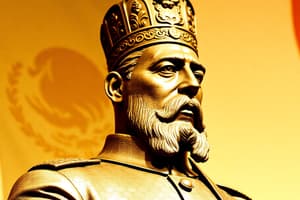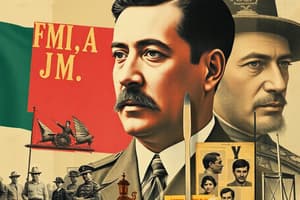Podcast
Questions and Answers
During the Porfiriato, General Porfirio Díaz maintained stability in Mexico by __________.
During the Porfiriato, General Porfirio Díaz maintained stability in Mexico by __________.
- Emphasizing freedom of speech
- Encouraging local leaders to engage in conflict (correct)
- Restricting the power of the army and police
- Promoting democratic elections
Which social groups did General Porfirio Díaz form alliances with during the Porfiriato?
Which social groups did General Porfirio Díaz form alliances with during the Porfiriato?
- Farm workers and miners
- Students and artists
- Church, landowners, and intellectuals (correct)
- Rebels and revolutionaries
What was a significant economic impact of the Porfiriato in Mexico?
What was a significant economic impact of the Porfiriato in Mexico?
- Decrease in exports to foreign countries
- Rapid industrialization in all regions
- Shift towards self-sufficiency in the economy
- Increased foreign investment and exports like minerals (correct)
Which region of Mexico was primarily known for its mining activities during the Porfiriato?
Which region of Mexico was primarily known for its mining activities during the Porfiriato?
Despite economic growth during the Porfiriato, who mainly benefited from it?
Despite economic growth during the Porfiriato, who mainly benefited from it?
In what ways did General Porfirio Díaz's government try to avoid him being seen as a dictator during the Porfiriato?
In what ways did General Porfirio Díaz's government try to avoid him being seen as a dictator during the Porfiriato?
Which sector saw significant industrialization during the Porfiriato?
Which sector saw significant industrialization during the Porfiriato?
What were the main characteristics of economic development in Mexico during the Porfiriato?
What were the main characteristics of economic development in Mexico during the Porfiriato?
Flashcards are hidden until you start studying
Study Notes
- Mexico was governed by General Porfirio Díaz from 1876 to 1911, known as the Porfiriato, a 35-year period marked by authoritarianism and economic modernization efforts.
- Díaz used political strategies to pacify the country, including encouraging local leaders to fight each other and strengthening the army and police control.
- Despite the stability brought by Díaz's government, it came at the cost of political repression and censorship, although he worked to avoid being seen as a dictator.
- Díaz formed alliances with powerful social groups like the church, landowners, and intellectuals known as "los científicos" who justified radical policies for Mexican progress.
- Economically, Mexico saw significant development during the Porfiriato, opening up to foreign investors, primarily British and American, leading to a boom in exports like minerals and some industrialization.
- Regional economic differences existed in Mexico during this period, with mining in the north, agriculture in the central valley, sugarcane in Morelos, and henequen plantations in Yucatán.
- Although there was economic growth, it mainly benefited a small part of the population, with most Mexicans living in poverty and having low wages, despite government efforts to improve education and literacy rates.
Studying That Suits You
Use AI to generate personalized quizzes and flashcards to suit your learning preferences.




